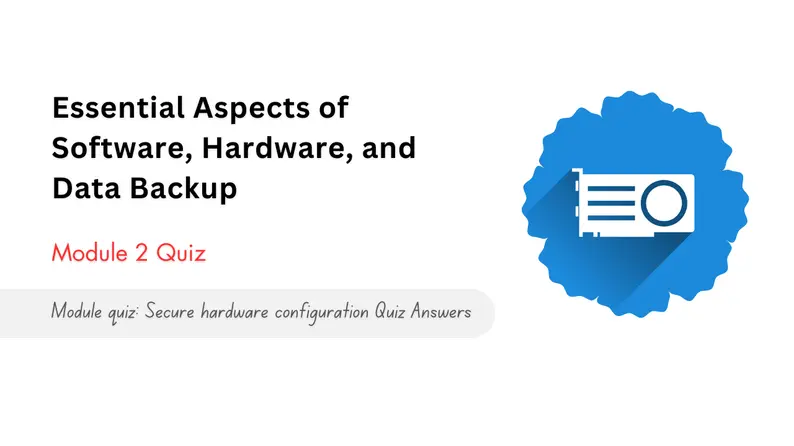Module quiz: Secure hardware configuration Quiz Answers
In this blog post, I will be sharing the answers to the Module 2 Quiz titled “Secure hardware configuration Quiz Answers” from the Coursera course “Essential Aspects of Software, Hardware, and Data Backup.”
Enroll Link: Essential Aspects of Software, Hardware, and Data Backup
Module quiz: Secure hardware configuration Quiz Answers
Question 1)
Besides protecting against theft, physical security measures also aim to mitigate damage or disruption caused by _____________________.
- natural disasters
- data breaches
- losing a device
- software malfunctions
Question 2)
Besides device theft, bring your own device (BYOD) policies introduce heightened risks of _______________, which refers to the use of unsanctioned software or services by employees.
- malware
- phishing attacks
- shadow IT
- hardware failure
Question 3)
Radio frequency identification (RFID) technology uses radio waves to identify and track objects with RFID tags. These tags contain electronically stored information that RFID readers can _______.
- store
- write
- read
- erase
Question 4)
What are the three broad categories of safeguarding methods for the physical protection of IT?
- Deterrents, detectors, preventatives
- Guards, alarms, locks
- Passwords, biometrics, one-time passwords (OTP)
- Policies, procedures, training
Question 5)
Hardware firewalls offer a dedicated defense mechanism between the internal network and the internet, unlike software firewalls that operate within individual ___________.
- Computers
- Servers
- Routers
- Operating systems
Question 6)
Your company wants to ensure the security of their devices. Which of the following actions demonstrates an understanding of the role original equipment manufacturers (OEMs) play in hardware security?
- Prioritizing an OEM partner that uses only top-of-the-line components
- Assuming all OEMs have the same security standards, prioritizing price over reputation
- Focusing exclusively on the security features offered by the final device manufacturer
- Thoroughly researching the security practices and reputation of OEMs who supply components for their devices
Question 7)
As a recently recruited cyber consultant, your new organization has concerns regarding security measures. The boss is worried that the safety procedures at start-up are not sufficient, as there is no secure way of recording the initialization configurations in the event of an unexpected shutdown. You assure him that that is not the case because TPM ensures a root of trust for measurement by having a record of which processes should run on boot-up stored in ___________.
- Non-volatile secure storage
- Azure Portal
- Centralized user and computer management
- Secure platform configuration registers
Question 8)
You have been tasked with encrypting the data contained within the company’s Windows laptops to add an extra layer of security. Your manager would also like the encryption keys to be stored and managed in Active Directory. Which built-in Windows tool would enable you to do this?
- Enigma Machine
- Windows Defender
- BitLocker
- Advanced Encryption Standard (AES)
Question 9)
True or False: Encrypting data stored on USB drives can help keep sensitive information secure, even if the device is lost or stolen.
- True
- False
Question 10)
After reviewing the computer settings, your boss flags a potential issue. He notes that if the computer has no power, how can the newly installed initialization safeguards be enacted? He worries that a hacker can power off the computer and intercept the boot process. You assure him that this is not possible because BIOS settings (like boot order and system time) are stored in a special memory chip powered by the ____________ battery.
- RAM
- CMOS
- ROM
- RAID



